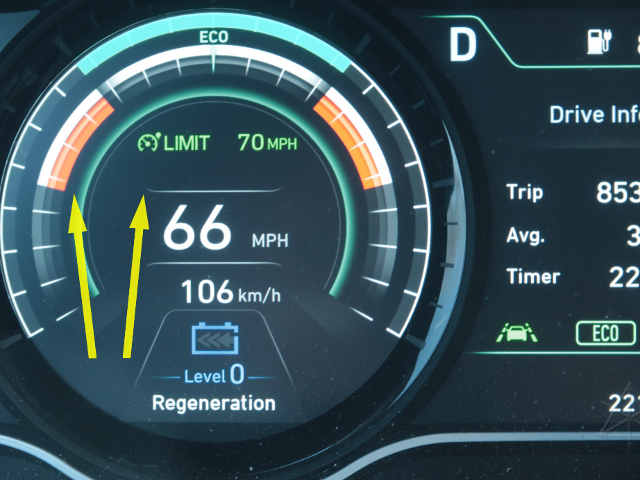This would seem an unlikely topic for an EV, as their motors are generally very efficient through a wide range of operating conditions. One thing I got used to in the Prius was holding its combustion engine in its much narrower efficient running range, leading to extensive discussion of keeping it in the "sweet spot" of optimal load conditions. I got very used to locking my foot in the appropriate position for hours at a stretch, to basically drive in a constant-power scenario. Cruise-control is Right Out for any such experiments, as its response is far too agressive on even slight uphill/downhill changes and the Prius engine RPM and load would be all over the place. The result of holding steady power was a good bit of speed variation from the terrain, rather similar to what happens to a loaded semi with an underpowered day-cab. I found myself "pulling the hills" just about like they were, and would often just follow along a healthy distance behind a truck that looked like it was running about the same effective power-to-weight ratio.
We don't really have to worry about any of this with electric motors, however, but it's basically ingrained into the way I drive now. I may use cruise-control a bit more now, mostly in the flatlands, but even there I'll slowly bump the speed down a couple MPH on the small rises over highway bridges and bump back up on the downside, just to limit the peak kilowatt output a little. For live driving, my foot still naturally finds a sort of comfortable narrow range to stay in and I don't try to push hard up the hills, so the scenario in the Kona is still similar. I rarely ask for more than 30 or 40 kilowatts anyway, and that seems to be plenty for normal highway travel and the slightly slower uphills that I'm used to. On a recent trip I decided to try and quantify it a little better and find a convenient visualization, similar to the tach in the Prius which sat right below my road sightline.
The Kona's instrument binnacle is positioned a little lower than that, but glancing at it is easier than squinting at the little yellow number in the "electricity use" screen. I always run in "Eco" mode with that crazy green and white expanding-arc display; the size of the green varies based on the car's pitch angle and I assume it's supposed to be a suggestion of where to limit power, indicated by the white line matching the green, for best running efficiency. Going past it brings on fat orange sections, presumably a warning against pushing too hard. But following that guideline would have us poking along interstates at about 50 MPH, clearly not what we want. So even though I'm driving efficiently and usually pulling around 4.0 mi/kWh anyway, plentiful orange segments are frequently present. Where they end is actually consistent with requested power, so I can use that as a much quicker visual to self-limit my foot.
It turns out that bringing the orange stripe down just to match the upper line of the speed display yields right around 30 kilowatts output:

In other words, fortyish horsepower, and less than a quarter of what the Kona is capable of! This yields modest but quite adequate acceleration, and even maintaining fairly close to my normal 70-ish on gradual uphills. I usually use the speed limiter set to 70 anyway, so locking my foot here almost behaves like a cruise-control until I need to back off for slower running or whatever.
The "suggested power" display gets all screwy when the speed limit is set, with all of the orange bits *disappearing* above 68 MPH but no change in the output. I can disable the speed-control instantly [and bring back the orange bars] by enabling the cruise-control but not setting a speed, which I sometimes use for completing a pass or a fast coast down a big hill. The limiter will actually force going into regen on a big downhill with no feet on the pedals, as active cruise also will.
Limiting output not only yields incrementally more efficiency, but more importantly it limits motor torque and excess high-current heating in the battery and electrics. Staying away from high motor torque may have benefits by not aggravating a problem that some Konas seem to have with premature powertrain wear-out. There are several VERY long-running threads about failed motor and reduction-gearbox units at the Inside EVs forum, and its analog in the UK ...
Traction motor replacement
Repair issues (roughly at where that discussion begins)
Drive train funny noise
and many others, with the usual symptom being slow development of various tapping or klunking noises which get steadily worse. The Kona community is *still* trying to track this and determine the root cause. My theory is that may be more likely to happen and/or sooner from aggressive driving. [The community also agrees that the gearbox oil-change interval should be far shorter than recommended, especially early in the car's life.] My usual style probably contributed greatly to the Prius going more than 280K miles in my care, with absolutely no engine issues and the original hybrid battery, and I expect it would be good for just about any vehicle.
Oddly, my 2019 Kona made a tiny hint of the suspect noise but only when slowing right before a stop under fairly heavy regen, and never seemed to develop any further during its grievously short life. The 2021, thankfully, doesn't have the noise at all, and hopefully it'll stay that way -- at around 20K at this time of writing, so far so good.